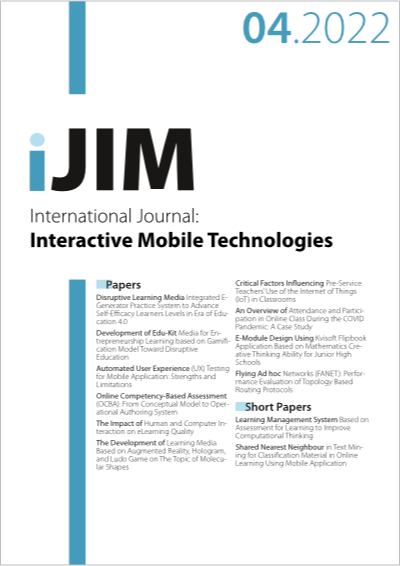Automated User Experience (UX) Testing for Mobile Application: Strengths and Limitations
DOI:
https://doi.org/10.3991/ijim.v16i04.26471Keywords:
User Experience (UX), Automated UX Evaluation, UX Evaluation, Moderated UX Evaluation, Mobile ApplicationsAbstract
User Experience (UX) evaluation has a significant importance for any interactive application. Mobile device applications have additional limitations to convey good user experiences (UX) due to the usage and features of mobile devices in ubiquitous computing contexts. There are a lot of automated tools available for evaluating, such applications particularly developed for Android and iOS. Automated UX evaluation provides a number of strengths which are able to overcome the limitations of non-automated (moderated) counterparts. Automated UX evaluation is regarded as unexplored field, especially when it is adopted for the UX evaluation of complex mobile application. Despite these, automated UX evaluation tools are unexplored and should only be used in coupling with traditional UX evaluation techniques. Hence, this study aims to discuss the literature in automated UX evaluation and to highlight the UX measurements that merit further investigation. This paper presents the most frequently used automated UX evaluation tools for mobile applications. Therefore, the study analyzes existing automated UX tools and frameworks and identifies which UX attributes and measurements of automated UX evaluation are likely to be of use in future research. Moreover, we discuss the strengths and limitations of automated UX evaluation methods for mobile applications. Finally, the paper provides an overview of automated UX evaluation techniques and tools. It also presents the strengths and limitations for comparing various evaluation methods.
Downloads
Published
2022-02-28
How to Cite
Abuaddous, H. Y., Saleh, A. M., Enaizan, O., Ghabban, F. M., & Al-Badareen, A. B. (2022). Automated User Experience (UX) Testing for Mobile Application: Strengths and Limitations. International Journal of Interactive Mobile Technologies (iJIM), 16(04), pp. 30–45. https://doi.org/10.3991/ijim.v16i04.26471
Issue
Section
Papers
License
Copyright (c) 2022 Hayfa Y. Abuaddous, Ashraf Mousa Saleh, Odai Enaizan, Fahad M Ghabban, Anas Bassam Al-Badareen

This work is licensed under a Creative Commons Attribution 4.0 International License.



